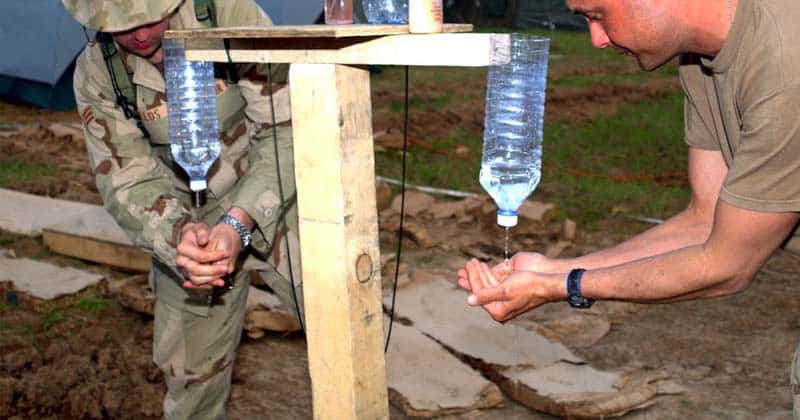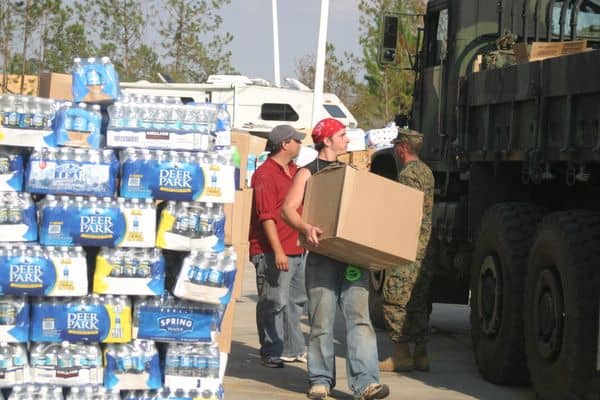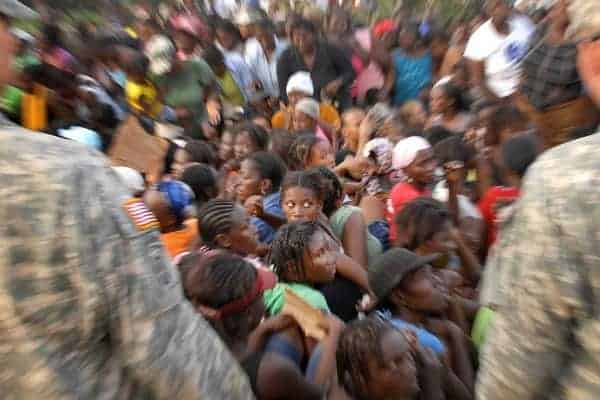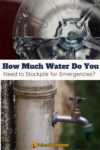Water is an essential you need to store for emergencies. Not only do you need it for drinking, but you also need water for preparing food and hygiene.
But how much water do you need to stockpile?
The short answer is that you need at least 14 gallons of water per person. That breaks down to 1 gallon per day for 2 weeks.
However, most people use much more water than this. To be fully prepared, you’ll want to aim for 60-120 gallons of water per person. That would give you 2-4 gallons of water to last 30 days.
Everyone’s needs are different, though. Below, I’ll detail how to calculate how much water your family needs for emergency preparedness.
Use our Emergency Water Calculator to determine how much your family needs to stockpile.
How Much Water to Stockpile Per Day?
Ready.gov, National Terror Alert, and FEMA recommend stockpiling 1 gallon of water per person daily. This is based on the idea that you’ll need ½ gallon for drinking and another ½ gallon for other purposes, such as hygiene and cooking.
While ½ gallon of drinking water is adequate for most people’s needs, ½ gallon is NOT enough for other needs.
Simply flushing a toilet with a bucket of water requires approximately one gallon. Even if you follow “if it’s yellow, let it mellow,” you will still use a lot of water just for flushing.
Add in all the other water that goes down the drain when doing things like washing hands, and you can quickly blow through several gallons of water per day.
Water Conservation As Part of Your Preparedness Plan
The better you are at conserving water, the less water you will need to stockpile for your family. Don’t wait until an emergency hits to figure out water conservation methods, or you will go through it faster than you anticipated.
Here are some ways that you’ll be able to conserve water during emergencies.
Stockpile No-Cook Meals:
I’m a big advocate of stockpiling foods like dry beans and rice for long-term emergencies. However, these foods take a lot of water and electricity to cook.
Thus, readymade/no-cook foods are a much better choice for short-term emergencies. These include cereal, granola bars, canned soups, and canned meals. See our foods to store for survival.
Use Hand Sanitizer:
You should have hand sanitizer in your emergency supplies to prevent the spread of disease after a disaster. While washing hands is still better than hand sanitizer, it can help you use less water.
See: How to make DIY hand sanitizer
Wet Wipes for Showers:
Instead of showering with your water stockpile, use wet wipes to wipe yourself down.
Graywater Recycling:
Use buckets to save water graywater when washing your hands, clothes, or dishes. You can use this to flush toilets. For example, I have a friend who permanently disconnected the drain pipe under his bathroom sink. He puts a bucket under it to collect water and uses it to flush the toilet.
Read: What is greywater?
Hand Washing Stations:
Instead of just pouring water directly over your hands, you can do things like creating a “tippy tap” for washing hands with less water. See examples of water-conserving handwashing stations here.

Waterless Toilets:
Flushing toilets use a lot of water. You could switch to a waterless toilet during a long-term emergency where you are without water. Read about two-bucket emergency toilets and composting toilets.
Bucket Washing Machine:
During a long-term disaster, you would eventually have to wash some clothes. Washing and rinsing clothes wastes a lot of water, though. A better solution is to make a “bucket washing machine.”
There are also plenty of water-conserving off-grid washing machines you can buy.
Methods for Washing Dishes:
I generally am against disposables because they are so wasteful. However, it’s wise to have a supply of disposable plates and utensils to use during emergencies if the water is off.
If you do need to wash dishes, use the three-basin method. The first basin contains a tiny bit of soapy water for rinsing food off plates. The second basin has a small amount of clean water for rinsing the soap. The final basin contains water with a bit of bleach in it. You dip the dishes in the bleach solution to disinfect them. Use 1 tsp of bleach per 1 gallon of water.
Run an Emergency Water Drill
The only way to know precisely how much water your family needs to stockpile for emergencies is to run a water drill.
An Emergency Water Drill means you go without running water for a designated time. During this time, you only use your stockpiled water. At the end of the drill, you calculate how much water you went through.
The first time my family of four did a water drill, we used nearly 20 gallons of water. After some practice, we got that number down to 6 gallons per day – or 1.5 gallons per person per day.
For my family, it broke down to ½ gallon of drinking water per person, 3 gallons of water for cooking and personal hygiene (we only cook dinner – other meals are canned), and 1 gallon of water for flushing the toilet just once per day (yes, it’s a bit gross but saves water).
Tips for Running an Emergency Water Drill:
- The drill should last at least 3 days. Any less than this, and you won’t get an accurate assessment of how much water you need to get through an emergency.
- Plan your drill for a long weekend or period when you will be mostly at home. If you use water while not at home, this will impact the accuracy of your calculations. If you must leave home, then bring water with you to use.
- Do an “Off-Grid” drill at the same time as your water drill. During an Off-Grid exercise, you won’t use any electricity from the grid. This will give you a better idea of how you’d use water during an emergency and help you better prepare for a grid-down disaster.
- If you need to use water from the tap, put it into gallon bottles and write down the amount. You want to make sure your calculations are accurate.
How Many Days Do You Need to Stockpile Water For?
Ready.gov recommends stockpiling a minimum of 3 days’ worth of water. FEMA recommends stockpiling at least 2 weeks’ worth of water. However, because water outages can last for much longer than this, everyone should aim to have at least a 30-day supply of water stockpiled.
How Long Do Water Outages Usually Last?
Most water outages only last a few days, so some disaster agencies only recommend having 3 days’ worth of water stockpiled. Even if the outage lasts longer, emergency response teams usually mobilize quickly and hand out supplies like bottled water.
It’s not wise to rely on the government to help you through an emergency, though. Consider the February 2021 snowstorm, which left over 14 million people without drinking water in Texas. Free bottled water was available – but would you risk driving on the icy roads and then standing in line in freezing temperatures to get water?
While rare, some disasters result in water outages that last for much longer. Hurricane Laura caused water outages that lasted for weeks.
A month after Hurricane Maria, 1/3 of Puerto Rico was still without water.
After the 2011 earthquake in Japan, it took two weeks just to start water line repairs and 68 days to restore water to some areas – and Japan is a country famous for its good infrastructure and organization.
Sources: CBC, OPB, Aljazeera, Circle of Blue, CNN, IITK (PDF)

The Possibility of Long-Term Water Outages
Many people don’t realize how fragile and outdated our water systems are. Many aren’t designed to withstand a major disaster.
For example, an analysis by one of the leading water suppliers in Washington State found that a large offshore earthquake would disrupt water services for up to 60 days.
Or consider that parts of Haiti went 6 years without running water after the devastating earthquake of 2010. The lack of water for hygiene then resulted in a cholera outbreak, affecting 7% of the population.
Yes, the USA is much more developed than places like Haiti and probably could recover faster. However, a significant disaster (such as an EMP attack) could leave people without water for weeks or months.

Build Up Your Water Supply Slowly
Start by stockpiling a 3-day water supply and work up to 30 days. After that, you can gradually build up to a long-term emergency water supply. While working on that, you can start building up your 2-week food supply list and your non-food stockpile list.
Pet Water Requirements
Don’t forget to calculate extra emergency water for your pets. To determine how much water your cat or dog needs, take the animal’s weight in pounds and divide it by 8. This is approximately the amount of water they need per day in cups. Read more about emergency preparedness for pets here.
What If You Run Out of Water during an Emergency?
What happens if you don’t stockpile enough emergency water and run out? Here are some solutions for finding water in an emergency.
- Rainwater harvesting: Have some buckets or barrels at home. These can be used to gather water from your downspouts. Tarps can also be used for rainwater harvesting. Read more about rainwater harvesting.
- Get water from your water heater: Read how to do that here.
- Source water from nature: There are survival tricks like creating solar stills, which allow you to get water from plants or other natural sources. Read how to find water in the wilderness.
- Drinking urine: Hopefully, it won’t come to this. Read about drinking urine for survival.
Emergency Water Purification
Remember that you can’t safely drink water from rivers, rainwater from downspouts, or other emergency water sources. You’ll need to purify the water first. For more on that, read:
- Disaster Water Purification Systems
- Can you Drink Filtered Water During a Boil Order?
- How to Use Bleach to Purify Water
- Best Water Filters for Emergency Preparedness
Ready to start stockpiling emergency water?
Read our posts on How to Store Emergency Water and Best Water Storage Containers.
How much water do you have stockpiled? Do you think it will be enough? Let us know in the comments.



Hand pump a country well, permission would be a thought
How about water from a swimming pool?
A swimming pool can definitely be used as an emergency water supply. But, depending on how you want to use it, you’ll also need a way to purify it. For cleaning and power-flushing toilets, this is pretty easy. I’d rather rely on stockpiled water or rainwater for drinking though!
I broke through the ice on my pool heated it and we all stayed clean and with a hint of chlorine, 10 days with out power!
I keep around 6-12 bottles holding 1.5 L each. I live about 20 mins by foot away from a stream that provides clean drinking water, so refilling is an option.
Thanks a lot to Diane for this excellent article!
Having a natural source of water nearby is fantastic. I’d still keep more water at home though. They are so many situations where you might not be able to leave your home to resupply. I personally live in a flood-prone area so couldn’t go to the nearby river to refill. Hopefully this isn’t an issue where you live.